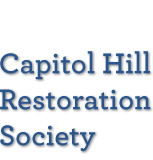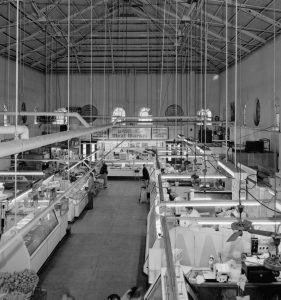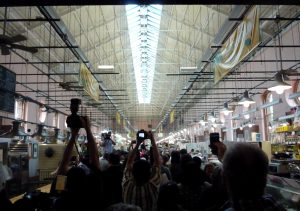Celebrating Eastern Market for 150 Years – Preservation Cafe
Posted on March 18th, 2023
Robert Pohl, local historian, author, and tour guide, presented “Celebrating Eastern Market for 150 Years,” a talk about Eastern Market – the building and its history, at an in-person Preservation Café, March 30, 2023, in the Eastern Market North Hall – operating continuously since it first opened in 1873.
Other events celebrating the Eastern Market’s anniversary can be found on the Cherry Blossom Calendar.
The presentation was preceded by a brief Membership Meeting.
A synopsis of the presentation, prepared by Christine Mullins:
On March 30, nearly 150 CHRS members gathered in the North Hall of Eastern Market to hear Robert Pohl, local historian, author, and Washington D.C. tour guide, describe the history of Eastern Market which will celebrate 150 years of serving the Capitol Hill community on Nov. 12, 2023.
A rarity among U.S. historic marketplaces, Eastern Market continues to serve as a shopping and social space for Capitol Hill residents – a purpose it was designed for when it opened in 1873.
Pohl began his talk by noting that the urban plan Pierre L’Enfant designed in 1791 for Washington, D.C. reserved several central spaces to build marketplaces across the city. The first Capitol Hill market space appeared around 1793 as the Capitol building was being built to serve the workmen and congressmen who congregated there.
The city opened a second market in 1813, built right down the center of East Capitol Street because it had no other space near the Capitol available. A legend grew up about this market – that it was used in the slave trade. Abraham Lincoln, when he was a young Representative, wrote about seeing enslaved people being driven to a slave pen. However, the pen he wrote about is not on Capitol Hill. The East Capitol market closed in 1838, 10 years before Lincoln arrived in Washington.
The building we see today at Eastern Market was the brainchild of Joseph Carroll. The city supported its location 1871 as a convenience for the residents planners wanted to remain in the area. Pohl quipped that everyone wants to live two blocks from a market, but no one wants to live across the street.
Adolph Cluss, a German immigrant who was a friend of Karl Marx and Friedrich Engels, designed the Eastern Market structure to be built of brick which he preferred because it was less pretentious than marble. The market opened on Nov. 12, 1873, with a celebratory serenade from the Holy Hill Band.
In 1908, the market was expanded according to a design by Snowden Ashford, an accomplished architect the city hired to design several DC municipal buildings. Ashford added Eastern Market’s Center Hall and the North Hall.
Pohl showed a 1914 photo of the layout of market stalls that featured 51 vendors that sold butter, eggs, flowers, meat, and poultry, with a bakery, delicatessen, and a cafe on a second floor of the building. The basement largely remained empty except for a brief two-year stint as a rifle range during World War I.
Eastern Market would continue to be a center of activity on Capitol Hill, but its role as a food seller to the community became gradually less critical as refrigeration became more prevalent in people’s homes. Several times, the community had to rally to keep it open.
Only two vendors remained in 1958: Southern Maryland Seafood and Union Meat Company. In 1962 only one meat counter remained, down from 22 during its heyday. Pohl showed pictures of the North Hall being used to house an art exhibit in 1961, and sell books to raise money for the local schools in 1963.
Eastern Market was rejuvenated with an influx of new vendors when the city closed the downtown Northern Liberty Market in 1963. Eastern Market was designated a D.C. Historic Landmark in 1964, and listed in the National Register of Historic Places in 1971.
Although designs were floated to upgrade the market with restaurants and upscale vendors – to mimic central Philadelphia’s Reading Market – Capitol Hill’s Eastern Market would remain the same for many years to come because the owners and vendors could not agree on how to remodel the space.
Then, during the early hours of April 30, 2007, Capitol Hill residents awoke to the sound of fire sirens and the smell of smoke. In a matter of hours, flames had engulfed and critically damaged the structure of the building. But the community, led by the Capitol Hill Community Foundation, rallied around their landmark and Mayor Adrian Fenty pledged to rebuild the damaged market and restore its historic architectural features the day after the blaze.
The $22 million restoration has received universally high praise. The marketplace continues to be busy and the North Hall has since become a popular civic and art venue and center of the neighborhood.
This presentation was supported by Eastern Market and the Department of General Services as part of the Eastern Market 150-Year Anniversary Celebration.
Our CHRS Preservation Cafés are free to both CHRS members and non members.





